-
TrackoBit
Manage commercial vehicles with the new-age Fleet Management Software
TrackoBit -
TrackoField
Streamline your scattered workforce with Field Force Management Software
TrackoField -
Features Resources
-
Blog
Carefully curated articles to update you on industrial trends. -
White Paper
Insightful papers and analysis on essential subject matters. -
Glossary
Explore an alphabetical list of relevant industry terms. -
What’s New
Get TrackoBit & TrackoField monthly updates here. -
Case Study
Explore the cases we solved with our diverse solutions. -
Infographics
Explore key topics through visually impactful infographics.
-
About Us
Get to know TrackoBit: our team, ethos, values, and vision. -
Careers
Join the most dynamic cult of coders, creatives and changemakers. -
Tech Support
Learn about our technical support team and services in detail. -
Events
Check out the exhibitions where we left our marks and conquered. -
Contact Us
Connect with us and let us know how we can be of service.
What is Fleet Management? How It Works, Benefits & More
- Author:Tithi Agarwal
- Read Time:8 min
- Published:
- Last Update: March 24, 2025
Table of Contents
Toggle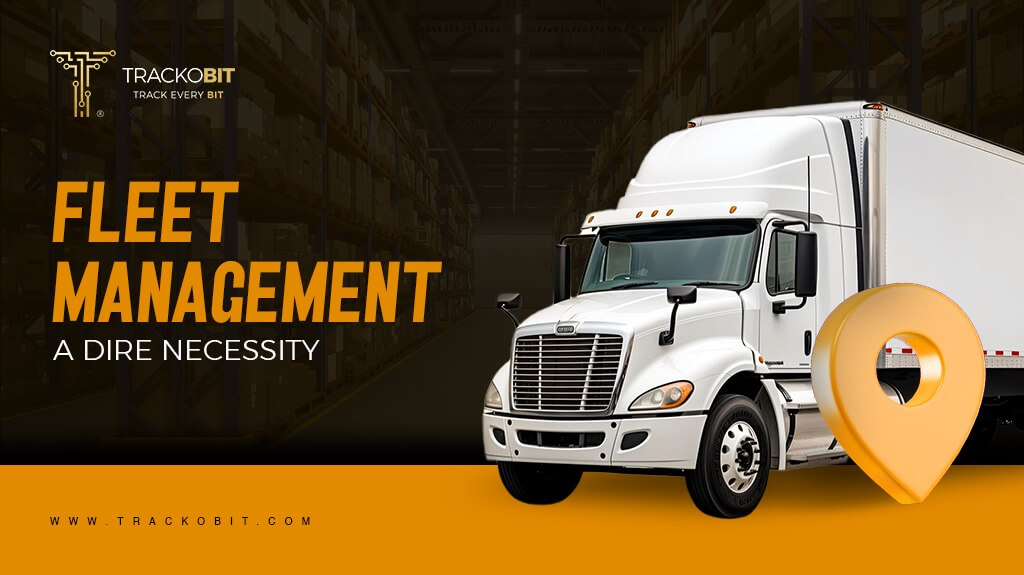
If you want your fleet operations to be optimised, you need proper fleet management. And what better way to assist with this process than fleet management software?
Table of Contents
Toggle
Fleet management is important for businesses that rely on transportation. It helps them use vehicles efficiently, control costs, improve productivity, and reduce risks. Good fleet management can bring many benefits, such as
- Improved vehicle acquisition
- Fuel savings,
- Improved safety,
- and lower carbon emissions.
75% of managers say that using fleet management software has made it easier to manage vehicle-related tasks. In this article, we explain fleet management software’s purpose, importance, and benefits. We also discuss how using it with telematics can make it even more effective.
Keep reading to learn more!
What is the Purpose of Fleet Management?
Fleet management is how a company maintains the fleet’s health. Of course, this is a broad statement that includes a variety of managerial tasks. Nonetheless, the goal of fleet management is to maintain control over the vehicle trips.
It aims to boost output and reduce resource use. The management supervises operations and schedule maintenance. This ensures that vehicles remain at the top of their health.
Fleet management businesses use vehicle telematics and fleet management software, such as TrackoBit. With its help, they can boost fleet productivity and save operating expenses.
Why is Fleet Management Important?
Fleet management matters mainly because it can improve overall operational efficiency.
Fleet management is vital for businesses, no matter how many trucks they have—one or ten thousand. It helps with –
- Tracking vehicle locations,
- Checking their condition,
- Scheduling maintenance
- And managing fuel use.
This reduces costs and extends the life of the equipment.
The main goal of fleet management is continuous improvement. It focuses on tracking vehicles, improving safety, and managing their lifecycle.
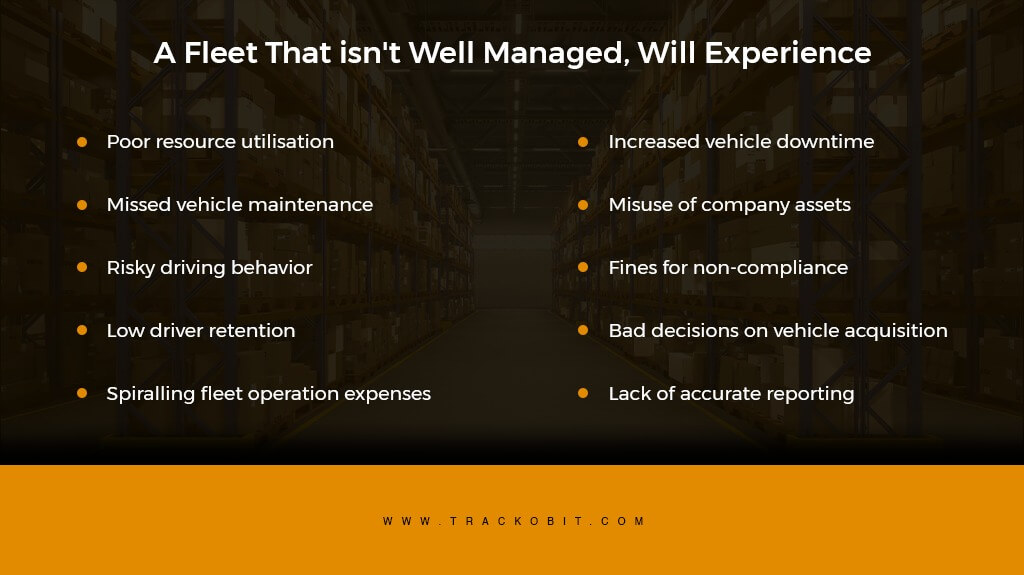
Fleet that is not well managed
A fleet that isn’t managed, or isn’t managed well, will likely experience some or all, of the following problems:
- Spiraling logistics operation expenses related to fuel consumption, overtime, and insurance.
- An increase in accidents, with damage to persons and property.
- Misuse of company assets, with no real-time visibility or asset tracking. As there is no monitoring of usage.
- Fines related to non-compliance and risk management become more difficult.
- Risky driving behavior or low driver retention.
- Disorganized or missed fleet maintenance of vehicles. Leading to uncontrolled maintenance costs and no maintenance schedules.
- Lower standards of customer service and lack of route planning. Thus increasing delivery times and fuel usage.
- Poor resource utilisation, increased downtime, and a lower return on capital invested.
- Bad decisions related to vehicle acquisition or disposal.
- A lack of accurate reporting can make business forecasting impossible.
Running a fleet is expensive, but a good manager can save money. The savings they create in operations and equipment expenses often cover their cost.
Managers use software to automate tasks. This reduces paperwork, improves accuracy, and ensures important events are not missed.
How Fleet Management Works?
Every vehicle-dependent company follows the same procedure. It is done so that successful and efficient strategies can be implemented.
1. Vehicle procurement:
Fleet management involves getting vehicles through buying or leasing to meet business needs. Managers must plan purchases wisely. This way, they can support company goals and keep operations running smoothly.
2. Monitoring fuel efficiency:
Fuel is one of the biggest expenses for fleets, so managing it well is essential. You must monitor activities such as
- vehicle idle,
- over speeding,
- tire pressure,
- routing,
- and vehicle size, weight, and type.
This way, you can control fuel efficiency and cut expenses.
3. Addressing vehicle usage:
This is the process of figuring out –
- where your trucks are,
- what they’re doing,
- who’s driving them,
- and when they’re being used.
Also, it addresses why and how to run them more efficiently.
4. Managing driver behavior:
Successful operations depend on drivers adhering to your company’s policies. Your trucks may increase productivity by motivating drivers with coaching and rewards. Also, performance indicators and feedback are a big help.
5. Minimizing operational costs and risks:
Fleets should evaluate the highest operational costs, such as
- crashes,
- overhead expenses,
- fines for non-compliance,
- and excessive fuel use.
Seek ways to minimize them through proper protocols.
Managers face constant pressure to cut costs, enforce safety and reduce risk. Not to mention, they must also increase productivity and output.
They use software, data analytics, and telematics to handle these challenges. These tools help them manage their fleets more effectively.
Benefits of Fleet Management in Logistics
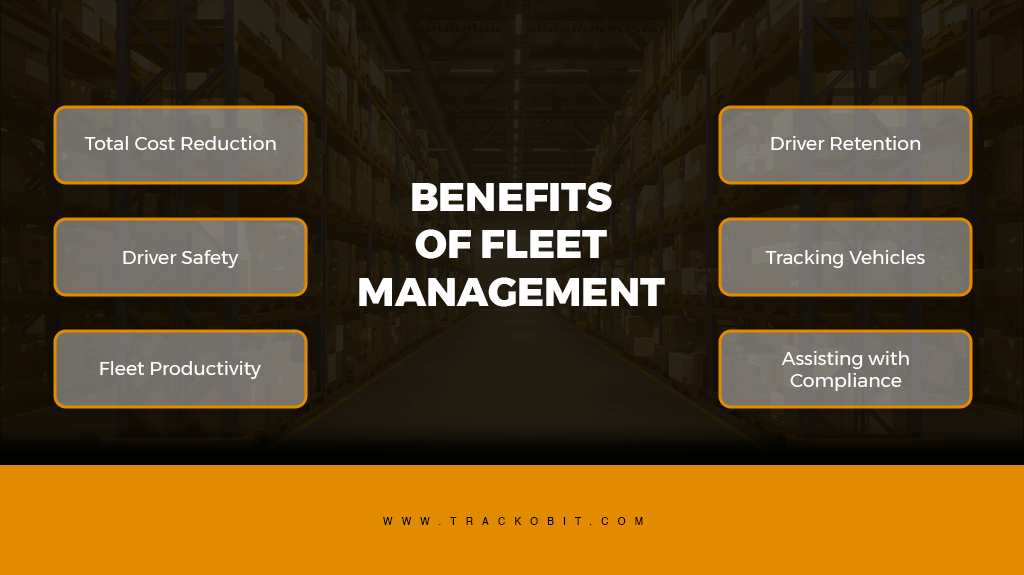
Benefits of Fleet Management
1. Total Cost Reduction
Effective management helps lower the total cost of ownership (TCO). There are several ways to achieve this:
- Using better route planning to save fuel.
- Buying vehicles at the best prices to cut costs.
- Staying compliant to avoid fines.
- Performing regular maintenance to prevent bigger issues and slow down depreciation.
These strategies make vehicle management more cost-effective
2. Driver Safety
Driver safety is a key responsibility in fleet management. Regular inspections and maintenance keep vehicles in good condition.
A strong management plan also promotes safe driving. It trains drivers on safety techniques and how to handle accidents.
3. More Productivity
Vehicles must be productive to be efficient. Productivity is measured by comparing miles driven to resources used. The goal is for the miles traveled to be higher than the costs.
Managers use key performance indicators (KPIs) to find areas for improvement. To do this, they must collect and analyze relevant data.
Read Blog – Top 12 Fleet Management KPIs
4. Better Driver Retention
Keeping current drivers and hiring new ones is important, especially during driver shortages.
Good fleet management builds trust between managers and drivers. This trust comes from promoting safety and open communication. Better working conditions lead to a happier and more loyal workforce.
5. Improved Efficiency
Managers play a key role in planning and adjusting routes.
They track routes to find problems and improve delivery times. They also adjust driver schedules to balance workloads efficiently.
6. Great Assistance with Compliance
Fleet management ensures compliance with laws and regulations wherever a vehicles operates. It helps prevent drivers from exceeding legal driving hours or skipping required inspections.
What is a Fleet Manager Responsible For?
Fleet managers oversee both wider strategic movements and typical day-to-day operations, including:
1. Fuel Management
Fuel makes up 25% of a fleet’s expenses, making it one of the biggest costs, except for electric fleets. Simply put, fuel is expensive.
Oil prices change, managers can’t control that. However, they can reduce fuel use to lower costs. With the right strategies, they can find ways to save money.
2. Vehicle Acquisition
Choosing the right vehicles is a big responsibility for managers. A wrong decision can lead to financial losses.
It’s a tough task. There are many vehicle options, and factors like resale value, insurance, and taxes affect the choice to buy or lease. Managers must budget wisely, pick the right vehicles, and negotiate with automakers.
3. Vehicle Maintenance
Once automobiles are acquired, they must be maintained. This calls for putting together a vehicle maintenance schedule.
Vehicles will inevitably develop physical deterioration, flaws, and component problems over time. Thus, managers must ensure that every vehicle is inspected before purchase and routinely inspected thereafter.
Read Blog – 11 Popular Myths About Vehicle Maintenance
4. Vehicle Tracking
If managers can’t track vehicle locations, many problems can arise. Drivers may take longer routes without real-time tracking. Thus leading to safety risks and higher fuel costs.
Without asset tracking, managers can’t provide delivery updates or estimate arrival times. They also struggle to analyze routes and avoid traffic delays.
Tracking vehicles is a major challenge, whether the fleet is small or large. That’s why managers rely on GPS technology for better visibility.
5. Compliance
Managers have legal obligations in addition to aspects of fleet management that are deemed best practices to fulfill. More specifically, all fleets must adhere to a set of on-road criteria.
Complying with regulatory standards entails regularly conducting vehicle checks, managing driver hours, confirming thorough technical inspections, ensuring insurance validity, staying current on laws, and organizing relevant documentation.
Compliance is essential, especially after an incident, to enable a precise audit if a complaint or inquiry is made later. Companies that neglect to keep their fleet compliant may face steep fines, litigation, and irreversible harm to their brand.
The Role of Telematics in Fleet Management
Telematics technology is commonly integrated into fleets via vehicle on-board diagnostic (OBD) ports to provide data into software platforms. Access to telemetry data can encourage safer, more eco-friendly driver behavior and influence compliance with fleet policies. In addition, telematics systems can:
- Improve customer service through the use of real-time GPS monitoring, trip reporting and routing.
- Provides in-car driver coaching, risk and driver behavior reporting, crash notifications, reconstruction, and location tracking for missing or stolen vehicles or equipment.
- Use predictive maintenance and remote diagnostics to streamline maintenance and remote diagnostics.
- It will help monitor idling and other driving habits for fuel management.
- Simplify compliance with easy tools for electronic logging, Hours of Service (HOS), and driver vehicle inspection reporting (DVIR).
- Integrate with other software systems, such as onboard camera technology or CRM software, and even create new applications.
Manage electric vehicles (EVs) while reducing a fleet’s environmental impact and carbon emissions.
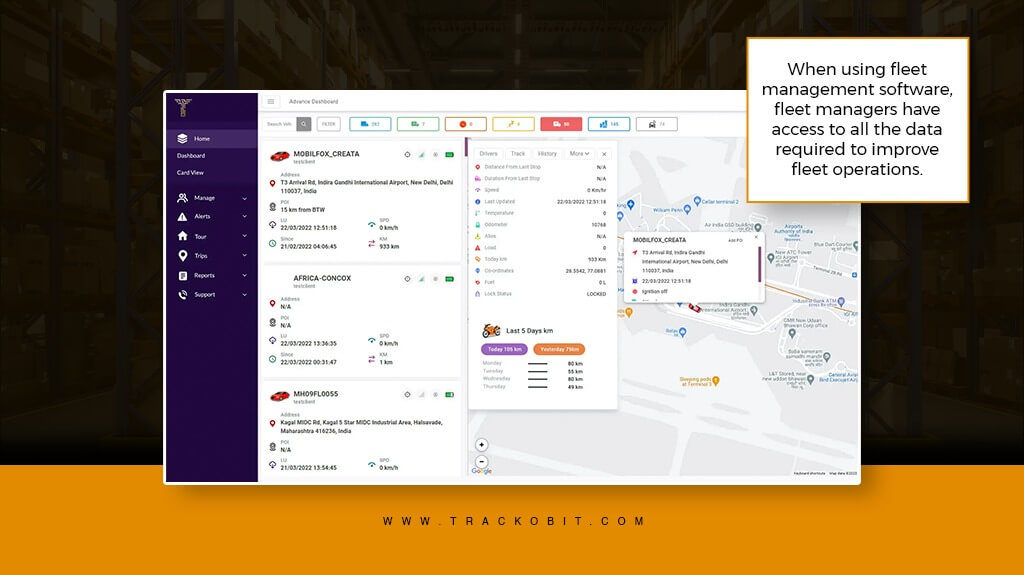
TrackoBit Dashboard
Why Businesses Should Use TrackoBit’s Fleet Management Software?
TrackoBit’s software offers many benefits. It’s fleet management improves driver behavior, analyzes costs, and provides real-time vehicle tracking.
Key features include:
- Location & Performance Tracking:
- The software tracks vehicles in real-time and provides insights into efficiency. It presents data in a clear and easy-to-understand format.
- Driver Safety Monitoring: It identifies risky behaviors like speeding or hard braking. Managers can use this data to coach drivers and improve safety.
- Regulatory Compliance: The system helps fleets follow federal and state laws, including DVIR and ELD regulations.
- Preventative Maintenance: Managers can schedule regular maintenance to prevent breakdowns and extend vehicle life.
- Quick Data Access:
- The driver app allows fast data transfer and easy access to information. This helps detect and fix issues before they turn into bigger problems.
With these features, TrackoBit makes fleet management more efficient and reliable.
So, what are you waiting for, get yourself a free demo today!
Tithi Agarwal is an established content marketing specialist with years of experience in Telematics and the SaaS domain. With a strong background in literature and industrial expertise in technical wr... Read More
Related Blogs
-

How to Use Driver Behavior Reports as a Sales Hook to Close Big Fleets
Tithi Agarwal October 16, 2025TrackoBit’s driver behavior reports empower fleet providers to win big contracts by showcasing safety, efficiency, and measurable ROI.
-
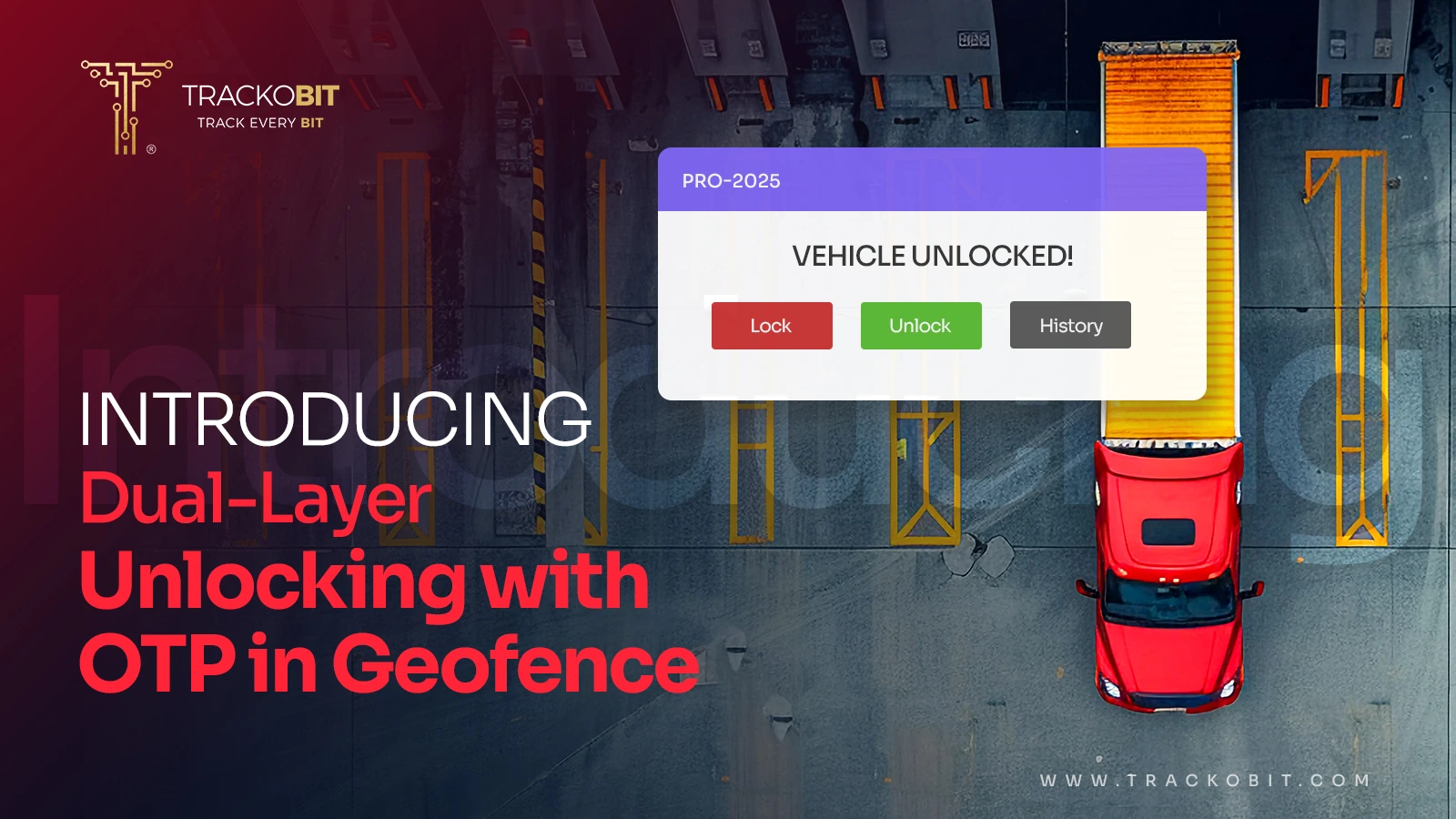
TrackoBit’s Unlocking in Geofence with OTP: Elevating Cargo Protection
Tithi Agarwal September 16, 2025TrackoBit’s latest feature – Unlocking in Geofence with OTP lets you lock out theft and unlock cargo only at the…
-

The Rise of Electric Fleets: Challenges and Opportunities for Businesses
Tithi Agarwal September 4, 2025The global fleet landscape is poised for a decade-long transformation. This change is being powered by electricity. Logistics-led businesses are…
-
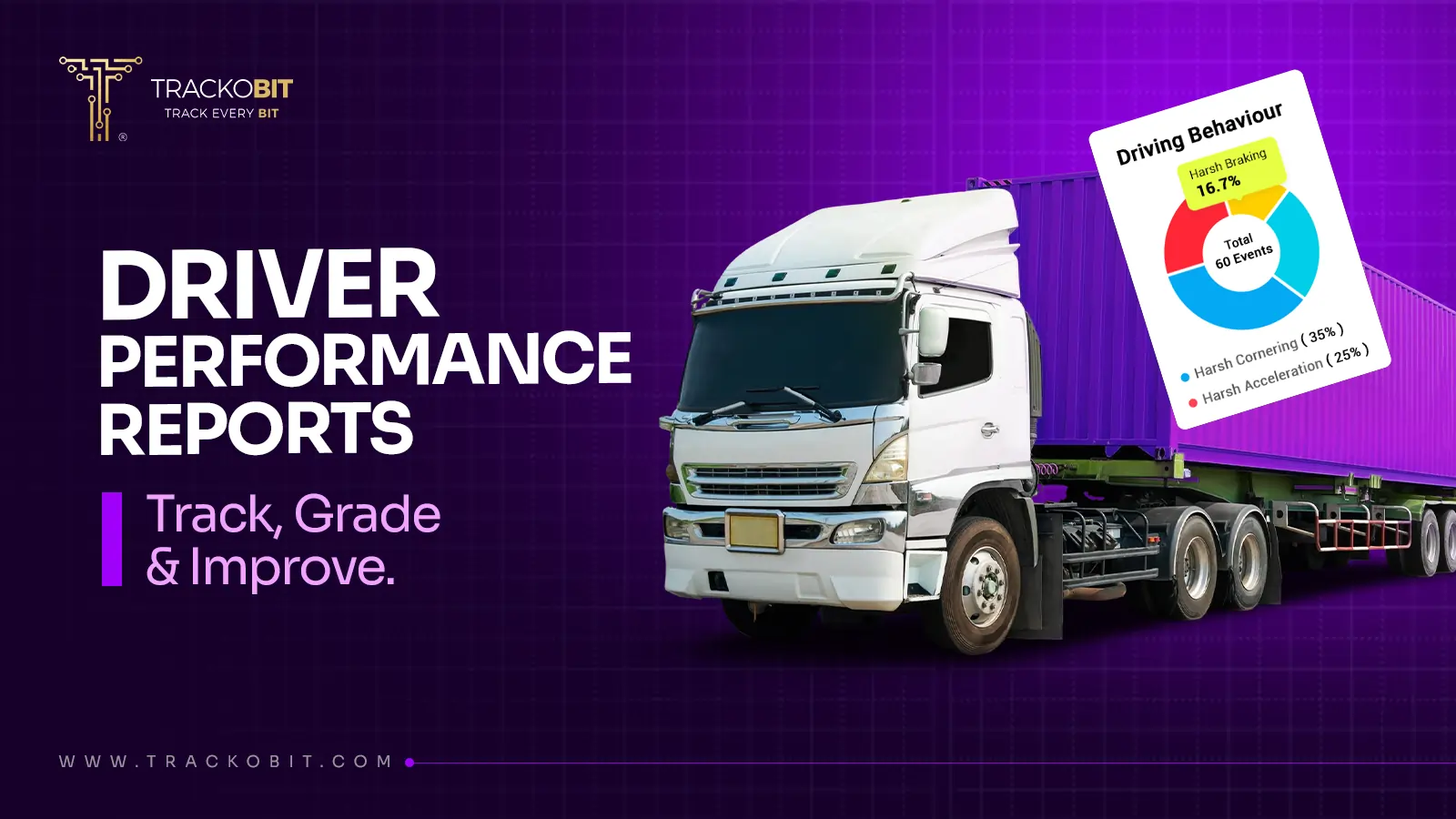
Who’s Really Behind the Wheel? Unlocking Insights with Driver Performance Reports
Tithi Agarwal August 27, 2025Identify top-performing drivers, monitor violations, and grade skills with the driver performance report. This makes fleet operations more transparent and…

Subscribe for weekly tips to optimize your fleet’s potential!
Your inbox awaits a welcome email. Stay tuned for the latest blog updates & expert insights.
"While you're here, dive into some more reads or grab quick bites from our social platforms!"Stay Updated on tech, telematics and mobility. Don't miss out on the latest in the industry.
We use cookies to enhance and personalize your browsing experience. By continuing to use our website, you agree to our Privacy Policy.



































